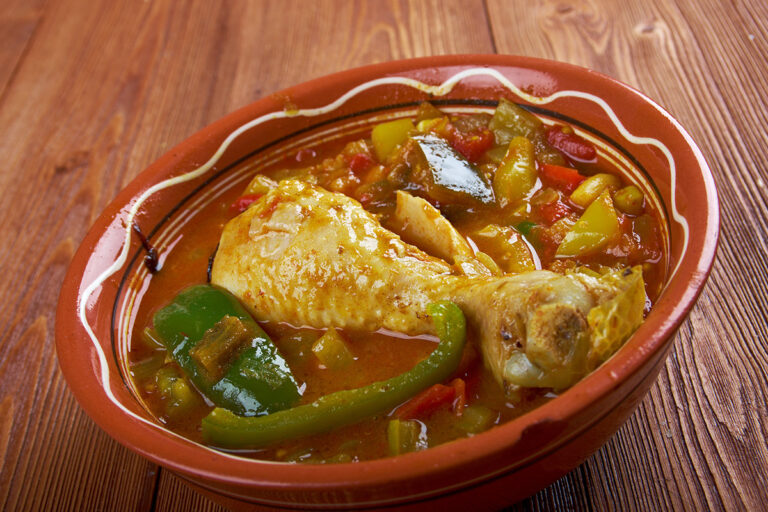Introduction: Angolan Cuisine
Angolan cuisine is a fusion of diverse African and European culinary traditions, reflecting Angola’s history of colonization and cultural exchange with neighboring countries. The country’s cuisine is characterized by the use of locally grown ingredients, such as cassava, peanuts, beans, and palm oil, as well as seafood and meat dishes. Given Angola’s location in southern Africa, it is influenced by various neighboring countries, including Portugal, the Congo, Namibia, Zambia, South Africa, and Gabon.
Portuguese Influence on Angolan Cuisine
Portugal’s colonization of Angola from the 16th to the 20th centuries had a profound impact on the country’s cuisine. Portuguese influence is evident in dishes such as calulu, a stew made with dried fish, vegetables, and palm oil, and feijoada, a bean and meat stew served with rice. The Portuguese also introduced wine and bread to the Angolan diet.
In addition, they brought over new spices, such as cinnamon, cloves, and paprika, which became staples in many Angolan dishes. Portuguese influence is also evident in Angolan desserts, such as pudim de leite (milk pudding) and bolo de bolacha (cookie cake).
Congo’s Influence on Angolan Cuisine
Angola shares a border with the Congo, and as such, Congolese influence is evident in Angolan cuisine. Angola adopted the Congolese stew known as moamba de galinha, a dish made with chicken, palm oil, and vegetables. Cassava, a staple crop in both countries, is central to the cuisine of both Angola and the Congo.
Moreover, Angolan cuisine features Kizaka, a Congolese dish that consists of cassava leaves cooked with salt and peanuts. Cassava leaves are also used in Angola’s version of the Congolese dish called pondu, which is made with cassava leaves, palm oil, and spices.
Angola’s Connection to Namibian Cuisine
Angola’s border with Namibia has also influenced its cuisine. The Angolan version of Namibia’s kapana, a popular street food made with grilled meat, has become a staple in Angola.
Likewise, Namibia’s influence can be seen in the use of game meat in Angolan cuisine. Game meat, such as kudu and springbok, is commonly served in Angola, and it is often prepared in the Namibian style.
How Angolan Cuisine is Influenced by Zambia
Angola shares its eastern border with Zambia, which has influenced its cuisine. Zambia’s staple foods, such as nshima (a cornmeal porridge) and biltong (dried meat), have become part of Angola’s culinary culture.
The Zambian dish called chikanda, a ball-shaped snack made from ground peanuts, has also become popular in Angola. Additionally, Zambian influence is evident in Angolan dishes such as chicken or beef stew, which often include Zambian spices and vegetables such as okra.
South African Influence on Angolan Cuisine
South African cuisine has also influenced Angolan cuisine, particularly in the use of spices and the preparation of meat. Angolans have adopted the South African spice blend called peri peri, which is made from spicy chili peppers, garlic, and lemon juice.
Angolan cuisine also features sosaties, which are kebabs made with marinated meat, a preparation method common in South Africa. Additionally, the South African dish called bobotie, a casserole made with spiced meat and topped with an egg custard, has become popular in Angola.
Gabon’s Influence on Angolan Cuisine
Lastly, Gabonese influence is present in Angolan cuisine, particularly in the use of smoked fish. Gabonese smoked fish is commonly used in Angolan dishes such as calulu and arroz de marisco (seafood rice).
Additionally, Angolans have adopted the Gabonese dish called maboke, which consists of fish cooked in banana leaves. This dish is similar to the Angolan dish called moqueca, which also involves cooking fish in a palm oil sauce.
Conclusion: Diverse Influences on Angolan Cuisine
Angolan cuisine is a reflection of the country’s cultural heritage and its interaction with neighboring countries. Portuguese, Congolese, Namibian, Zambian, South African, and Gabonese influences have all contributed to the development of Angola’s culinary culture. The result is a unique fusion of African and European culinary traditions, with a distinctive Angolan twist.










